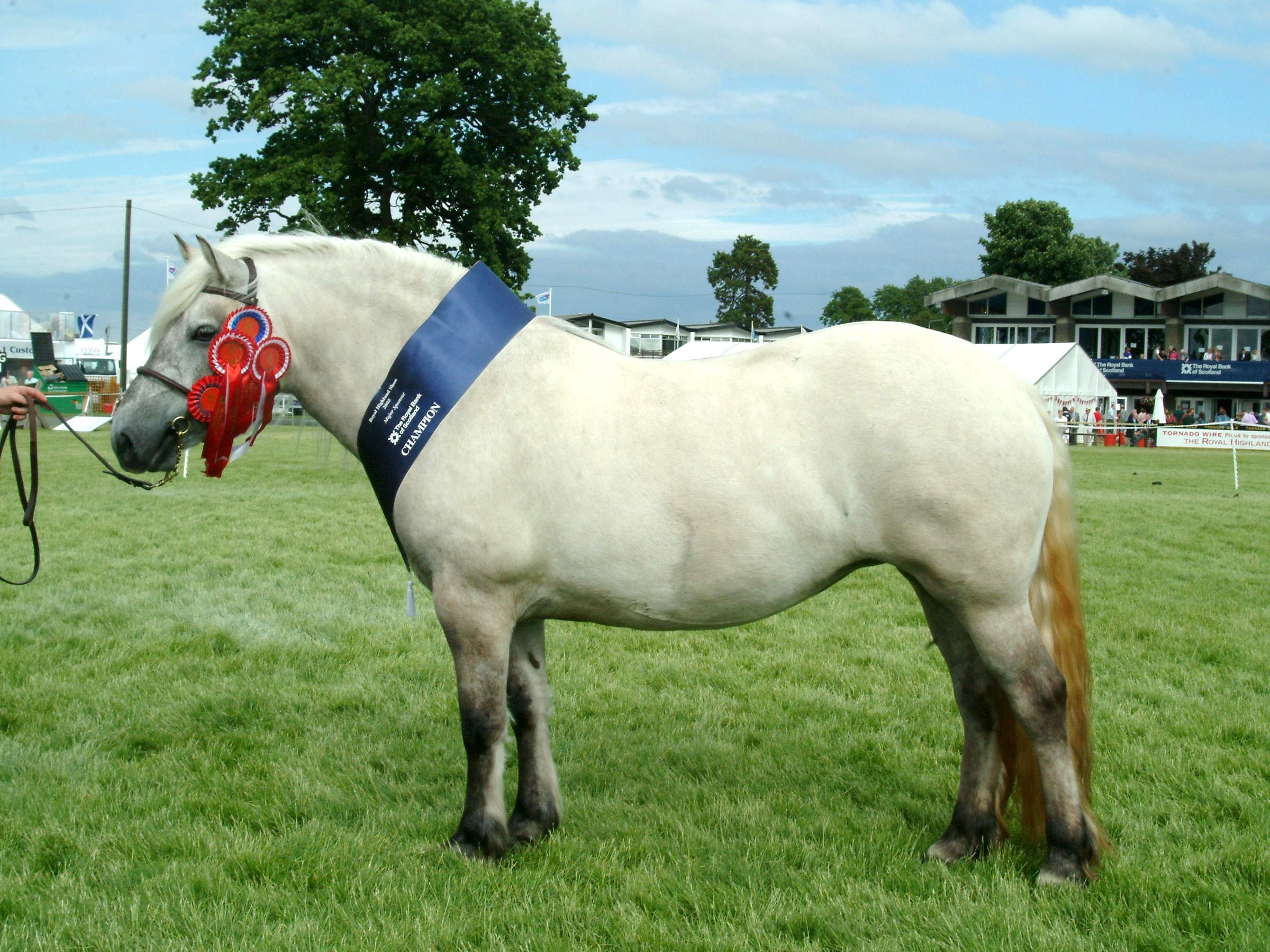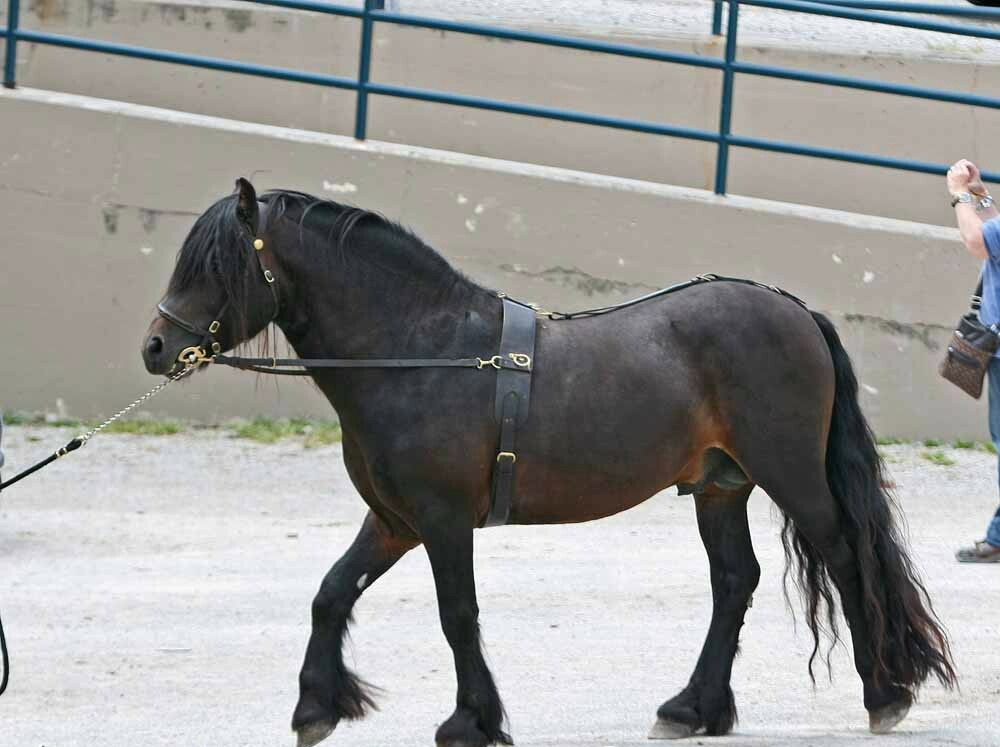|
Doug Wolaver
Doug Wolaver is a Tennessee Walking Horse trainer who has won the World Grand Championship in the Tennessee Walking Horse National Celebration three times. His winning horses were Mack K's Handshaker in 1960, Triple Threat in 1965, and Go Boy's Sundust in 1967. Life and career Wolaver was born in 1947/48 to Myron and Jean Clark Wolaver. He grew up on his family's farm near Cornersville, Tennessee and was exposed to horses and mules from a young age, as the family farmed with mules. His first exposure to horse shows came as a child, when he showed ponies owned by other people. Wolaver later began training the ponies himself, and his father Myron "Pap" Wolaver ultimately gave him a young Tennessee Walking Horse filly named Miss Merry Allen. Wolaver and Miss Merry Allen competed in the 1956 Tennessee Walking Horse National Celebration and won the Two-Year-Old Filly World Championship, starting Wolaver's career. Wolaver and the horse Mack K's Handshaker won the World Grand Champio ... [...More Info...] [...Related Items...] OR: [Wikipedia] [Google] [Baidu] |
Cornersville, Tennessee
Cornersville is a town in Marshall County, Tennessee, United States. The population was 1,228 at the 2020 census. The town is home to Cornersville high school. History Before becoming incorporated the town's name was Marathon. When it was first incorporated as a municipality on January 7, 1830, Cornersville was named for its location near the corner where Giles, Maury, Bedford and Lincoln counties came together. It was part of Giles County at the time of incorporation, but county boundaries have changed, and since 1870 it has been in Marshall County. Town of Cornersville official website, accessed March 19, 2019. Geography Cornersville is located at (35.358152, -86.841681). The town is concentrated around the intersection of |
Tennessee Walking Horse
The Tennessee Walking Horse or Tennessee Walker is a horse breed, breed of gaited horse known for its unique four-beat running-walk and flashy movement. It was originally Horse breeding, developed as a riding horse on farms and plantations in the American South. It is a popular riding horse due to its calm disposition, smooth gaits and sure-footedness. The Tennessee Walking Horse is often seen in the show ring, but is also popular as a pleasure and trail riding horse using both English riding, English and Western riding, Western equipment. Tennessee Walkers are also seen in movies, television, and other entertainment. The breed was developed beginning in the late 18th century when Narragansett Pacers and Canadian Pacers from the eastern United States were crossed with gaited Spanish Mustangs from Texas. Other breeds were later added, and in 1886 a foal named Black Allan (horse), Black Allan was born. He is now considered the foundation bloodstock, foundation sire of the breed. I ... [...More Info...] [...Related Items...] OR: [Wikipedia] [Google] [Baidu] |
Tennessee Walking Horse National Celebration
The Tennessee Walking Horse National Celebration (TWHNC), sometimes known as the Celebration, is the largest horse show for the Tennessee Walking Horse breed, and has been held annually in or near Shelbyville, Tennessee since its inception in 1939. The Celebration was conceived by Henry Davis, a horse trainer who along with several other horsemen, felt the Shelbyville area should have a festival or annual event. Although the Celebration was originally held in Wartrace, Tennessee, it moved to Shelbyville, the seat of Bedford County, a few years later. The Celebration spans 11 days and nights in late August and early September annually, and finishes with the crowning of the World Grand Champion Tennessee Walker on the Saturday night before Labor Day. The TWHNC draws an estimated 2,000 horses and 250,000 spectators to Shelbyville each year. History The Tennessee Walking Horse National Celebration was founded in 1939. A Wartrace resident, Henry Davis, went to Winchester, Tenne ... [...More Info...] [...Related Items...] OR: [Wikipedia] [Google] [Baidu] |
Mule
The mule is a domestic equine hybrid between a donkey, and a horse. It is the offspring of a male donkey (a jack) and a female horse (a mare). The horse and the donkey are different species, with different numbers of chromosomes; of the two possible first-generation hybrids between them, the mule is easier to obtain and more common than the hinny, which is the offspring of a male horse (a stallion) and a female donkey (a jenny). Mules vary widely in size, and may be of any color seen in horses or donkeys. They are more patient, hardier and longer-lived than horses, and are perceived as less obstinate and more intelligent than donkeys. Terminology A female mule is often called a "molly" or "Molly mule," though the correct term is "mare mule." A male mule is called a "john" or "John mule," though the correct term is "horse mule." A young male mule is called a "mule colt," and a young female is called a "mule filly." The donkey used to produce mules is called a "mule ja ... [...More Info...] [...Related Items...] OR: [Wikipedia] [Google] [Baidu] |
Horse Show
A horse show is a judged exhibition of horses and pony, ponies. Many different horse breeds and equestrianism, equestrian disciplines hold competitions worldwide, from local to the international levels. Most horse shows run from one to three days, sometimes longer for major, all-breed events or national and international championships. Most shows consist of a series of different performances, called ''classes'', wherein a group of horses with similar training or characteristics compete against one another for awards and, often, prize money. International organizations and competitions There are several international disciplines run under rules established by the ''International Federation for Equestrian Sports, Fédération équestre internationale'' (FEI): *Combined driving *Dressage *Endurance riding *Eventing *Para-equestrian *Reining *Show jumping *Horse showmanship, Showmanship *Tent pegging *equestrian vaulting, Vaulting *Western Pleasure The rules of the FEI govern com ... [...More Info...] [...Related Items...] OR: [Wikipedia] [Google] [Baidu] |
Pony
A pony is a type of small horse, usually measured under a specified height at maturity. Ponies often have thicker coats, manes and tails, compared to larger horses, and proportionally shorter legs, wider barrels, heavier , thicker necks and shorter heads. In modern use, breed registries and horse shows may define a pony as measuring at the withers below a certain height; height limits varying from about to . Some distinguish between horse or pony based on its breed or phenotype, regardless of its height. The word ''pony'' derives from the old French ''poulenet'', a diminutive of meaning foal, a young, immature horse. A full-sized horse may sometimes be called a pony as a term of endearment. Definition For many forms of competition, the official definition of a pony is a horse that measures up to at the withers. Standard horses are taller than 14.2. The International Federation for Equestrian Sports defines the official cutoff point at without shoes and with shoes ... [...More Info...] [...Related Items...] OR: [Wikipedia] [Google] [Baidu] |
Filly
A filly is a female horse that is too young to be called a mare. There are two specific definitions in use: *In most cases, a ''filly'' is a female horse under four years old. *In some nations, such as the United Kingdom and the United States The United States of America (USA), also known as the United States (U.S.) or America, is a country primarily located in North America. It is a federal republic of 50 U.S. state, states and a federal capital district, Washington, D.C. The 48 ..., the world of horse racing sets the cutoff age for fillies as five. Fillies are sexually mature by two and are sometimes bred at that age, but generally, they should not be bred until they themselves have stopped growing, usually by four or five.Ensminger, M. E. ''Horses and Horsemanship: Animal Agriculture Series.'' Sixth Edition. Interstate Publishers, 1990. p. 149-150 Some fillies may exhibit estrus as yearlings. The equivalent term for a male is a colt. When horses of either ... [...More Info...] [...Related Items...] OR: [Wikipedia] [Google] [Baidu] |
Stallion
A stallion is an adult male horse that has not been gelded ( castrated). Stallions follow the conformation and phenotype of their breed, but within that standard, the presence of hormones such as testosterone may give stallions a thicker, "cresty" neck, as well as a somewhat more muscular physique as compared to female horses, known as ''mares'', and castrated males, called ''geldings''. Temperament varies widely based on genetics and training, but because of their instincts as herd animals, they may be prone to aggressive behavior, particularly toward other stallions, and thus require careful management by knowledgeable handlers. With proper training and management, stallions are effective equine athletes at the highest levels of many disciplines, including horse racing, horse shows, and international Olympic competition. "Stallion" is also used to refer to males of other equids, including zebras and donkeys. Herd behavior Young female horses usually leave their band ... [...More Info...] [...Related Items...] OR: [Wikipedia] [Google] [Baidu] |
1940s Births
Year 194 ( CXCIV) was a common year starting on Tuesday of the Julian calendar. At the time, it was known as the Year of the Consulship of Septimius and Septimius (or, less frequently, year 947 ''Ab urbe condita''). The denomination 194 for this year has been used since the early medieval period, when the Anno Domini calendar era became the prevalent method in Europe for naming years. Events By place Roman Empire * Decimus Clodius Septimius Albinus Caesar became a Roman Consul. * Battle of Issus: Septimius Severus marches with his army (12 legions) to Cilicia, and defeats Pescennius Niger, Roman governor of Syria. Pescennius retreats to Antioch, and is executed by Severus' troops. * Septimius Severus besieges Byzantium (194–196); the city walls suffer extensive damage. Asia * Battle of Yan Province: Warlords Cao Cao and Lü Bu fight for control over Yan Province; the battle lasts for over 100 days. * First year of the ''Xingping'' era during the Han Dynasty ... [...More Info...] [...Related Items...] OR: [Wikipedia] [Google] [Baidu] |
Living People
Purpose: Because living persons may suffer personal harm from inappropriate information, we should watch their articles carefully. By adding an article to this category, it marks them with a notice about sources whenever someone tries to edit them, to remind them of WP:BLP (biographies of living persons) policy that these articles must maintain a neutral point of view, maintain factual accuracy, and be properly sourced. Recent changes to these articles are listed on Special:RecentChangesLinked/Living people. Organization: This category should not be sub-categorized. Entries are generally sorted by family name In many societies, a surname, family name, or last name is the mostly hereditary portion of one's personal name that indicates one's family. It is typically combined with a given name to form the full name of a person, although several give .... Maintenance: Individuals of advanced age (over 90), for whom there has been no new documentation in the last ten ... [...More Info...] [...Related Items...] OR: [Wikipedia] [Google] [Baidu] |
People From Marshall County, Tennessee
The term "the people" refers to the public or common mass of people of a polity. As such it is a concept of human rights law, international law as well as constitutional law, particularly used for claims of popular sovereignty. In contrast, a people is any plurality of persons considered as a whole. Used in politics and law, the term "a people" refers to the collective or community of an ethnic group or nation. Concepts Legal Chapter One, Article One of the Charter of the United Nations states that "peoples" have the right to self-determination. Though the mere status as peoples and the right to self-determination, as for example in the case of Indigenous peoples (''peoples'', as in all groups of indigenous people, not merely all indigenous persons as in ''indigenous people''), does not automatically provide for independent sovereignty and therefore secession. Indeed, judge Ivor Jennings identified the inherent problems in the right of "peoples" to self-determination, as i ... [...More Info...] [...Related Items...] OR: [Wikipedia] [Google] [Baidu] |




